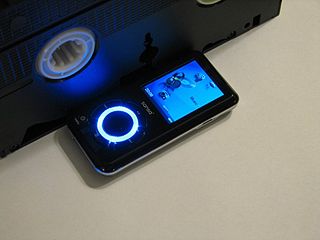Related Research Articles

Universal Serial Bus (USB) is an industry standard that allows data exchange and delivery of power between many various types of electronics. It specifies its architecture, in particular its physical interface, and communication protocols for data transfer and power delivery to and from hosts, such as personal computers, to and from peripheral devices, e.g. displays, keyboards, and mass storage devices, and to and from intermediate hubs, which multiply the number of a host's ports. USB was originally designed to standardize the connection of peripherals to computers, replacing various interfaces such as serial ports, parallel ports, game ports, and ADB ports, and prior versions of USB became commonplace on a wide range of devices, such as keyboards, mice, cameras, printers, scanners, flash drives, smartphones, game consoles, and power banks. It has evolved into a standard to replace virtually all common ports on computers, mobile devices, peripherals, power supplies, and manifold other small electronics. In the current standard the USB-C connector replaces the many various connectors for power, displays, and many other uses, as well as all previous USB connectors.
A de facto standard is a custom or convention that has achieved a dominant position by public acceptance or market forces. De facto is a Latin phrase, here meaning "in practice but not necessarily ordained by law" or "in practice or actuality, but not officially established".

Secure Digital, officially abbreviated as SD, is a proprietary, non-volatile, flash memory card format the SD Association (SDA) developed for use in portable devices.
The Nomad was a range of digital audio players designed and sold by Creative Technology Limited, and later discontinued in 2004. Subsequent players now fall exclusively under the MuVo and ZEN brands.

In computing, the Preboot eXecution Environment, PXE specification describes a standardized client–server environment that boots a software assembly, retrieved from a network, on PXE-enabled clients. On the client side it requires only a PXE-capable network interface controller (NIC), and uses a small set of industry-standard network protocols such as DHCP and TFTP.
The Media Transfer Protocol (MTP) is an extension to the Picture Transfer Protocol (PTP) communications protocol that allows media files to be transferred automatically to and from portable devices. Whereas PTP was designed for downloading photographs from digital cameras, Media Transfer Protocol allows the transfer of music files on digital audio players and media files on portable media players, as well as personal information on personal digital assistants. MTP is a key part of WMDRM10-PD, a digital rights management (DRM) service for the Windows Media platform. In 2011, it became the standard method to transfer files to and from Android.
3GP is a multimedia container format defined by the Third Generation Partnership Project (3GPP) for 3G UMTS multimedia services. It is used on 3G mobile phones but can also be played on some 2G and 4G phones.

The USB mass storage device class is a set of computing communications protocols, specifically a USB Device Class, defined by the USB Implementers Forum that makes a USB device accessible to a host computing device and enables file transfers between the host and the USB device. To a host, the USB device acts as an external hard drive; the protocol set interfaces with a number of storage devices.
Direct Cable Connection (DCC) is a feature of Microsoft Windows that allows a computer to transfer and share files with another computer, via a connection using either the serial port, parallel port or the infrared port of each computer. It is well-suited for computers that do not have an ethernet adapter installed, although DCC in Windows XP can be configured to use one if available.

gPhoto is a set of software applications and libraries for use in digital photography. gPhoto supports not just retrieving of images from camera devices, but also upload and remote controlled configuration and capture, depending on whether the camera supports those features.
Windows Image Acquisition is a proprietary Microsoft driver model and application programming interface (API) for Microsoft Windows Me and later Windows operating systems that enables graphics software to communicate with imaging hardware such as scanners, digital cameras, and digital video equipment. It was first introduced in 2000 as part of Windows Me, and continues to be the standard imaging device and API model through successive Windows versions. It is implemented as an on-demand service in Windows XP and later Windows operating systems.
Ethernet over USB is the use of a USB link as a part of an Ethernet network, resulting in an Ethernet connection over USB.

The RioForge is a digital audio player that was produced by Rio Audio, Inc. While it competed in the same market as Apple Inc's iPod mini, it is considerably different as it plays from internal memory, SD card, or FM broadcast and runs on a single AAA battery.
The USB video device class is a USB device class that describes devices capable of streaming video like webcams, digital camcorders, transcoders, analog video converters and still-image cameras.

The Sansa e200 series is a portable media player developed by SanDisk and released on January 5, 2006. The device is available in four capacities of Flash memory: 2 GB (e250), 4 GB (e260), 6 GB (e270), and 8 GB (e280). All players have a 1.8-inch, TFT LCD display with a resolution of 176 by 220 pixels. Certain files, if not in a format accepted by the player's original firmware, must first be converted with the Sansa Media Converter Windows software. This will convert images to bitmap format (.bmp) and videos to MJPEG, for v1 models. On v2 players it will convert videos to DivX and simply resize images. It is not possible to simply copy videos to the device, even if they seem to be in the correct format; trying to access them displays an error message.
Windows Rally is a set of technologies from Microsoft intended to simplify the setup and maintenance of wired and wireless network-connected devices. They aim to increase reliability and security of connectivity for users who connect the devices to the Internet or to computers running Microsoft Windows. These technologies provide control of network quality of service (QoS) and diagnostics for data sharing, communications, and entertainment. Windows Rally technologies provide provisioning for the following devices:

The Samsung SCH-u470, or Juke and Verizon Wireless Juke, is a mobile phone offered exclusively by Verizon Wireless. It was announced on 2 October 2007, and released that same year on Q4 in three colors: red, teal, and navy (blue). The phone is a music player when closed, and can be swiveled for use of the mobile phone. It also has a VGA-resolution camera with a special "night shot" mode for taking photos in low-light conditions.

FastPictureViewer is a freemium image viewer for Windows XP and later. Its aim is to facilitate quick review, rating and annotation of large quantities of digital images in the early steps of the digital workflow, with an emphasis on simplicity and speed. As an app with a freemium license, a basic version is available cost-free for personal, non-profit or educational uses, while a commercial license is required for the professional version with additional features. The basic version starts as a full version trial.

IEEE 1394 is an interface standard for a serial bus for high-speed communications and isochronous real-time data transfer. It was developed in the late 1980s and early 1990s by Apple in cooperation with a number of companies, primarily Sony and Panasonic. It is most commonly known by the name FireWire (Apple), though other brand names exist such as i.LINK (Sony), and Lynx.

USB Attached SCSI (UAS) or USB Attached SCSI Protocol (UASP) is a computer protocol used to move data to and from USB storage devices such as hard drives (HDDs), solid-state drives (SSDs), and thumb drives. UAS depends on the USB protocol, and uses the standard SCSI command set. Use of UAS generally provides faster transfers compared to the older USB Mass Storage Bulk-Only Transport (BOT) drivers.
References
- ↑ "ISO 15740:2013". ISO. Retrieved 2023-12-23.
- ↑ Steve Mann (1999-02-01). "University of Toronto WearComp Linux Project, part 1 of a 2-part series". Linux Journal . No. 58. p. 5. Retrieved 2013-12-28.
- ↑ "PTP Standards". www.imaging.org. Retrieved 2023-12-23.
- ↑ "PTP/IP - a new transport specification for wireless photography | IEEE Journals & Magazine | IEEE Xplore". doi:10.1109/TCE.2005.1405726 . Retrieved 2023-12-23.
- ↑ "About Windows Image Acquisition". MSDN . Microsoft . Retrieved 2009-01-05.
- ↑ "Still image connectivity for Windows". Microsoft. December 4, 2001. Retrieved 2009-01-05.
- ↑ "Learn Everything's - USB Connections: MTP, PTP, and USB Mass Storage". sites.google.com. Retrieved 2023-12-23.